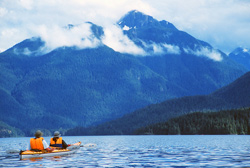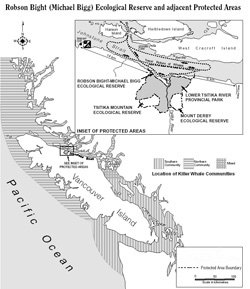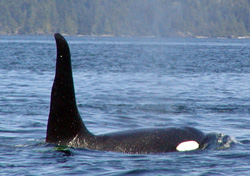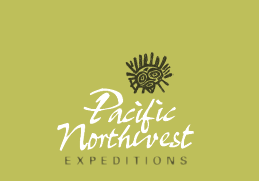|
Robson Bight
The Robson Bight (Michael Bigg) Ecological Reserve
Vancouver Island, British Columbia
What Are Ecological Reserves?
British Columbia ecological reserves are areas selected to preserve representative and special natural ecosystems, plant and animal species, features and phenomena. Ecological reserves are established for the:
- preservation of representative examples of British Columbia's ecosystems;
- protection of rare and endangered plants and animals in their natural habitat;
- preservation of unique, rare or outstanding botanical, zoological or geological phenomena;
- perpetuation of important genetic resources; and scientific research and educational uses associated with the natural environment.
Robson Bight
Robson Bight on the northeast coast of Vancouver Island is known as the world’s most likely place to see Killer Whales in the wild. It is also the mouth of the Tsitika River, which until about 1980 was the last watershed on the east coast of Vancouver Island that had yet to see industrial logging.
 The primary role of the Robson Bight (Michael Bigg) Ecological Reserve is to provide a sanctuary for killer whales and to protect significant killer whale habitat. It is the only sanctuary for killer whales on the west coast of Canada and is globally significant. The area is unique for its intensity of use by killer whales, and the range of activities engaged by them. Other marine mammals that occur in the area include humpback whales, Dall’s porpoises and Pacific white-sided dolphins. The primary role of the Robson Bight (Michael Bigg) Ecological Reserve is to provide a sanctuary for killer whales and to protect significant killer whale habitat. It is the only sanctuary for killer whales on the west coast of Canada and is globally significant. The area is unique for its intensity of use by killer whales, and the range of activities engaged by them. Other marine mammals that occur in the area include humpback whales, Dall’s porpoises and Pacific white-sided dolphins.
The ecological reserve also protects the only undisturbed estuary on the east coast of Vancouver Island, forested shorelines, and an environment rich with marine life due to strong tidal currents that produce constant mixing of Johnstone Strait waters. Up to 70 percent of the salmon heading for the Fraser River spawning grounds pass through the area.
The estuary has diverse flora and fauna, supports high populations of invertebrates, and is important feeding and rearing habitat for juvenile Coho salmon, Dolly Varden char, and herring. All five species of Pacific salmon, Steelhead trout, Cutthroat trout, Dolly Varden Char, and Eulachon migrate through the estuary to spawning grounds in the Tsitika River. The Tsitika River is important for its summer run of steelhead trout, which is the only significant run left on the east coast of Vancouver Island. The river system and associated mature forests is also an important flyway for the red-listed Marbled Murrelet and important breeding and foraging habitat for Northern Goshawks.
Area: 1,715 hectares (467 ha upland; 1,248 ha foreshore)
Date of establishment: June 17, 1982.
Robson Bight Ecological Reserve History
In 1972 the entire Tsitika River watershed was proposed to become an Ecological Reserve by the late biologist and author, Ian Smith. The reserve purpose was to protect an intact watershed as Roosevelt Elk habitat. Public hearings were held with Roderick Haig-Brown speaking passionately for protection of the Tsitika.
 The provincial government then recommended a multi-disciplinary committee be set up to resolve the conflict between forest and conservation interests. From 1976 to late 1978 a Tsitika Planning Committee met and deliberated on the fate of the Tsitika watershed. This committee was chaired by the Ministry of Forests, with at least one representative each from Canadian Forest Products, MacMillan Bloedel (M&B) and Western Forest Products. On the side of conservation were one Fish and Wildlife representative, a Federal Fishery representative, and an Ecological Reserves representative. Public and forestry worker union members were also on the committee. The provincial government then recommended a multi-disciplinary committee be set up to resolve the conflict between forest and conservation interests. From 1976 to late 1978 a Tsitika Planning Committee met and deliberated on the fate of the Tsitika watershed. This committee was chaired by the Ministry of Forests, with at least one representative each from Canadian Forest Products, MacMillan Bloedel (M&B) and Western Forest Products. On the side of conservation were one Fish and Wildlife representative, a Federal Fishery representative, and an Ecological Reserves representative. Public and forestry worker union members were also on the committee.
Basically it was decided to log the watershed, setting aside a few small Ecological Reserves that would quiet the public outcry and serve research purposes. M&B planned to build a log dump in the Tsitika River estuary which was then their private holding, bought back in the 1930's by H. R. MacMillan for $1.00.
However, Killer Whale research in the late 1970s and early 1980s was starting to indicate that Robson Bight (the bay at the mouth of the Tsitika River) was something special. It appeared to be a core area for seven to eight resident pods of Killer Whales (totalling 65-85 out of BC’s total population of around 300).
 Robson Bight is visited by the whales mainly from June to October. When the whales are present in Johnstone Strait there is an 80% chance that they will visit the Bight several times per day. The whales behave differently in Robson Bight; there is less travelling, less feeding, more resting, more play, and perhaps more sexual activity than in any other place on the BC Coast. Then it was discovered that the whales use certain beaches along the Bight for a “rubbing ritual”. The researchers also found that the whales were more sensitive to disturbance when they were at the rubbing beaches, or in the Bight. As a result of these findings and public pressure a 1,248 hectare totally marine Ecological Reserve was created in June 1982 to protect this core Killer Whale habitat. Robson Bight is visited by the whales mainly from June to October. When the whales are present in Johnstone Strait there is an 80% chance that they will visit the Bight several times per day. The whales behave differently in Robson Bight; there is less travelling, less feeding, more resting, more play, and perhaps more sexual activity than in any other place on the BC Coast. Then it was discovered that the whales use certain beaches along the Bight for a “rubbing ritual”. The researchers also found that the whales were more sensitive to disturbance when they were at the rubbing beaches, or in the Bight. As a result of these findings and public pressure a 1,248 hectare totally marine Ecological Reserve was created in June 1982 to protect this core Killer Whale habitat.
Over the years the Ecological Reserves Unit negotiated for the purchase of the M.B.’s private holding in the estuary. With funding from the Nature Trust, the $1.00 lot was purchased for the province for over $400,000.
In August 1988, the estuary and a narrow upland strip of land totalling 412 hectares along the Bight were incorporated into the Ecological Reserve. At its narrowest the reserve boundary is only 160 metres from the ocean.
Industrial Accident in the Robson Bight Ecological Reserve
On August 20, 2007 a barge carrying heavy equipment spilled its contents, including a truck carrying diesel fuel, into the Michael Bigg Ecological Reserve at Robson Bight. The spill happened 886-meters inside the reserve boundary.

|

